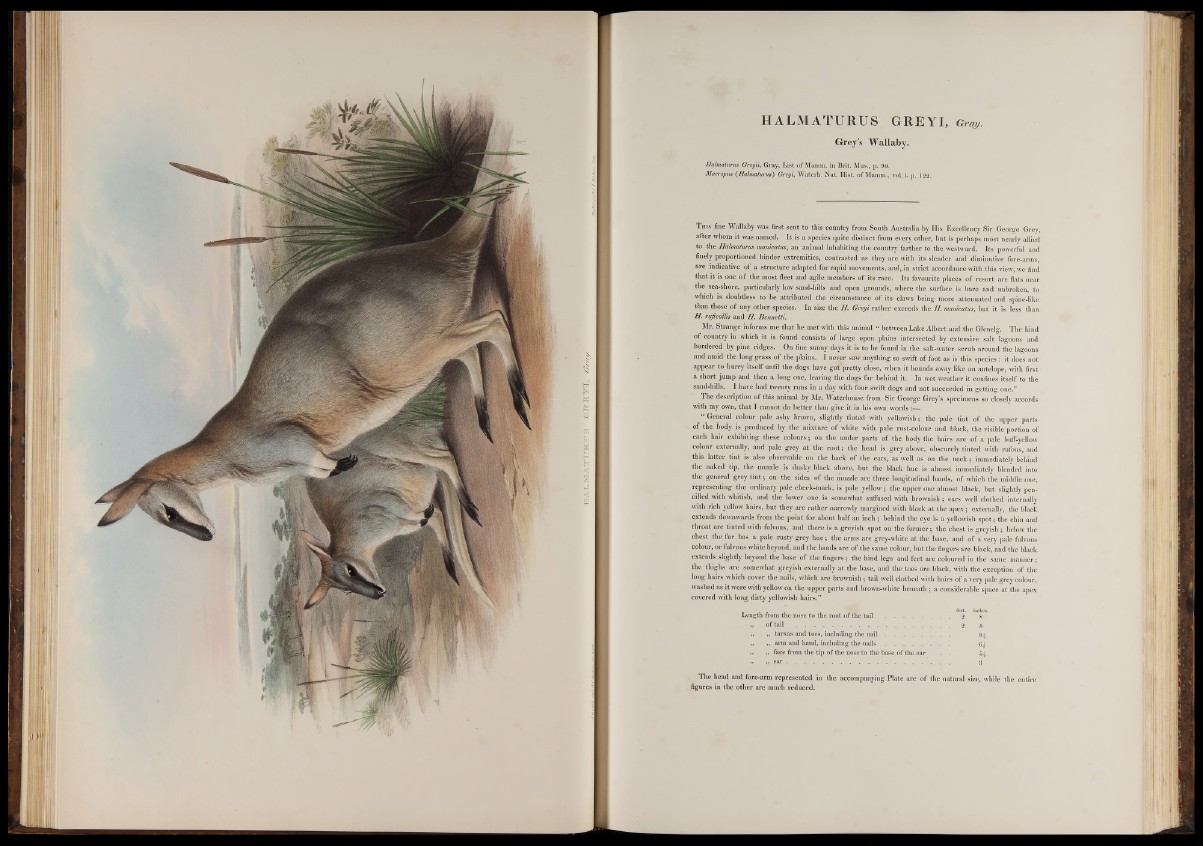
HALMATURUS GREYI, Gray.
Grey’s Wallaby.
Halmaturus Greyii, Gray, List of Mamm. in Brit. Mus., p. 90.
Macropus (Halmaturus') Greyi, Waterh. Nat. Hist, of Mamm., vol. i. p. 122.
Th is fine Wallaby was first sent to this country from South Australia by His Excellency Sir George Grey,
after whom it was named. It is a species quite distinct from every other, but is perhaps most nearly allied
to the Halmaturus manicatus, an. animal inhabiting the country farther to the westward. Its powerful and
finely proportioned hinder extremities, contrasted as they are with its slender and diminutive fore-arms,
are indicative of a structure adapted for rapid movements, and, in strict accordance with this view, we find
that it is one o f the most fleet and agile members of its race. Its favourite places of resort are flats near
the sea-shore, particularly low sand-hills and open grounds, where the surface is bare and unbroken, to
which is doubtless to be attributed the circumstance of its claws being more attenuated and spine-like
than those of any other species. In size the H. Greyi rather exceeds the H manicatus, but it is less than
H. ruficollis and H. Bennetti.
Mr. Strange informs me that he met'with this animal “ between Lake Albert and the Glenelg. The kind
of country in which it is found consists of large open plains intersected by extensive salt lagoons and
bordered by pine ridges. On fine sunny days it is to be found in the salt-water scrub around the lagoons
and amid the long grass of the plains. I never saw anything so swift of foot as is this species: it does not
appear to hurry itself until the dogs have got pretty close, when it bounds away like an antelope, with first
a short jump and then a long one, leaving the dogs far behind it. In wet weather it confines itself to the
sand-hills. I have had twenty runs in a day with four swift dogs and not succeeded in getting one.”
The description of this animal by Mr. Waterhouse from Sir George Grey’s specimens so closely accords
with my own, that I cannot do better than give it in his own words:■—•
“ General colour pale ashy brown, slightly tinted with yellowish; the pale tint of the upper parts
of the body is produced by the mixture of white with pale rust-colour and black, the visible portion of
each hair exhibiting these colours; on the under parts of the body the hairs are of a pale buff-yellow
colour externally, and pale grey at the root; the head is grey above, obscurely tinted with rufous, and
this latter tint is also observable on the back of the ears, as well as on the neck; immediately behind
the naked tip, the muzzle is dusky black above, but the black hue is almost immediately blended into
the general grey tin t; on the sides of the muzzle are three longitudinal bands, of which the middle one,
representing the ordinary pale cheek-mark, is pale yellow; the upper one almost "black, hut slightly pencilled
with whitish, and the lower one is somewhat suffused with brownish ; ears well clothed internally
with rich yellow hairs, but they are rather narrowly margined with black at the apex; externally, the black
extends downwards from the point for about half an inch ; behind the eye is a yellowish spot; the chin and
throat are tinted with fulvous, and there is a greyish spot on the former; the chest is greyish ; below the
chest the fur has a pale rusty grey hue; the arms are grey-white at the base, and of a very pale fulvous
colour, or fulvous white beyond, and the hands are of the same colour, but the fingers are black, and the black
extends slightly beyond the base of the fingers; the hind legs and feet are coloured in the same manner;
the thighs are somewhat greyish externally at the base, and the toes are black, with the exception of the
long hairs which cover the nails, which are brownish; tail well clothed with hairs of a very pale grey colour,
washed as it were with yellow on the upper parts and brown-white beneath ; a considerable space at the apex
covered with long dirty yellowish hairs.”
ieec. incnes.
Length from the nose to the root of the t a i l .............................................2 8
I "of tail ..................................... 2 5
„ „ tarsus- and toes, including the n a i l ....................................... 9_l
„ „ arm and hand, including the n a i l s ...................................... 6-f
,, „ face from the tip of the nose to the base of the ear . . . 54-
„ ,, ear ................................................................ ..... 3
The head and fore-arm represented in the accompanying Plate are of the natural size, while the entire
figures in the other are much reduced.